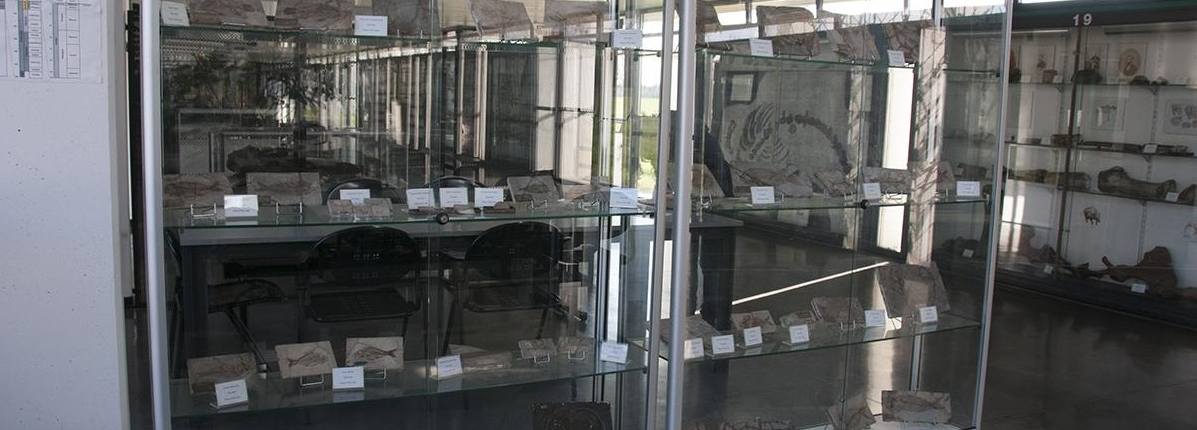The Paleontology collection originated from the paleontological section of the Cabinet of Natural History, the first core of which dates back to 1768. The history of the Cabinet and in particular the paleontological collections is linked not only to the historical events that marked the city, but also to the evolution of university teaching. Under the direction of Giuseppe Monici, between 1840 and 1847, the first nucleus of the paleontological section was established in the Cabinet of Natural History. Mainly thanks to Maria Luigia’s donations, the most important paleontological collections were acquired, today still partly exhibited in the Paleontology collection, such as the collection of fossil fishes from the Eocene of Bolca, the huge collection of fossil mollusks (about three hundred species) from the Plio-Pleistocene of Parma and Piacenza, collected by Cavezzali and Guidotti, and Cortesi’s paleontological collection consisting of vertebrate remains collected by him after 1809 in the Plio-Pleistocene of Piacenza, including an almost complete rhinoceros (which was destroyed by negligent packing on the return trip from the 1862 London World’s Fair), three minke whales, and two dolphins. In 1856 Podestà’s last major paleontological collection (a dolphin and two minke whales) was acquired.
Under the direction of Pellegrino Strobel, director from 1859 to 1895, and Girolamo Cocconi, who served as director between 1865 and 1867, the phase of reorganizing the material of the paleontological section of the Natural History Museum began. In 1884 Strobel listed among the holdings of the paleontological section of the Natural History Museum the collection of fossil shells (about 3,000 numbers) from the Parma and Piacenza area, a reunion of the Cavezzali, Guidotti, Bergonzi, Cortesi, and Podestà collections, revised and published by Cocconi in 1873, and other minor collections, gift of enthusiasts, five baleenopterids, three delphinids, and other parts of skeletons of the same, a skull of Bison prisco studied by Cuvier, skeletal parts of elephants and chelonians. In 1874 the first division of the Museum of Natural History into two separate sections, zoology and mineralogy-geology, derived from the division of the same chairs, took place.
In 1895, with the separation of the university chairs of mineralogy and geology, the mineralogical-geological section of the museum was divided into the Geological Museum and the Mineralogical Museum, both located in the University’s Central Building but on different floors. The Geological Museum had as its directors Vittorio Simonelli (1895-1924), Paolo Vinassa de Regny (1924-1941), Mario Anelli (1941-1952), and Sergio Venzo (1952-1978), who moved the Geological Museum from the University’s central building to the Institute of Geology’s headquarters in Via D’Azeglio, also changing its name to Museo Paleontologico Parmense. Since that time, the museum’s holdings have been augmented by material collected and studied by paleontologists first from the institute and then from the department, following the paleontological-stratigraphic direction of research.
A subsequent relocation took place in 1987 under the direction of Giuseppe Pelosio (1978-1999), when both the Institute and the Museum were placed in the new Earth Sciences plexus within the newly formed university science and technology hub. In the new and current location, the paleontological holdings, consisting mostly of artifacts (mainly mollusks) from Neogene deposits in western Emilia, a key area for the paleoclimatic evolution of the Mediterranean over the last 10 million years or so, are only partially on display. In fact, in the Department’s central corridor, for example, some dolphin and baleen whale remains that were part of the Podestà and Cortesi collections, a Pleistocene rhinoceros skull from the Stirone Creek, Eocene fish from Bolca, and mastodons from Columbia collected by Strobel can be seen. The remaining holdings are kept in three rooms of the Earth Sciences plexus that contain part of the malacological collections useful for research, in the Department’s storage rooms, and in the paleontological rooms of the Museum of Natural History (part of the vertebrates).
From 1999 to 2013, the direction of the Museum was assumed by the successive directors of the Department of Earth Sciences.
Since 2013, with the creation of the “M. Melloni” Department of Physics and Earth Sciences, the museum constitutes the paleontological section of the Museum of Physics and Earth Sciences, afferent to the department of the same name, along with the mineralogy section and the “Macedonio Melloni” scientific instruments section
Following the termination of the Department of Physics and Earth Sciences, the museums that were attached to it changed their names, thus no longer section but Museum of Paleontology.”
As of 2024, when the new Museum System Regulations come into effect, Paleontology becomes part of MuDeS Diffuse Science Museum as a museum educational collection.





